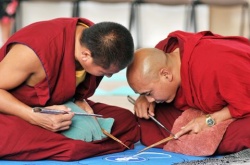Guanzhuba
Guanzhuba 管主巴 (Tib. bKa’ ‘gyur pa)
Guanzhuba was the General Secretary of the Buddhist Clergy in Songjiang Prefecture by imperial appointment in the early 14th century. The office of the Buddhist Clergy was one of the many offices under the administration of the Commission of Buddhist and Tibetan Affairs (Ch. Xuan zheng yuan). The Commission was responsible for the Buddhist affairs of the entire nation as well as local administration of Tibetan areas and was directed by the Imperial Preceptor.
Guanzhuba is thought to be of either Xixia or Tibetan descent, with a Tibetan education. According to a Chinese colophon to a Xixia text found in the Mogao Cave in Dunhuang dated to 1307, he was responsible for directing the printing and distribution of numerous significant Buddhist texts in Chinese, Xixia, and Tibetan script.
He is perhaps most known for the reprinting of the complete edition of the Xixia Tripitaka (Ch. Xixiazang) in the Dawanshou Monastery in Hangzhou in 1302 under the imperial command of Khubilai Khan (although Khubilai passed away in 1294). At the completion of printing, Guanzhuba distributed numerous copies to monasteries in areas of the former Xixia state. This reprint was based on an edition that was originally printed during the time of the Xixia state (1032-1226AD). Examining the wood-cut illustrations within both editions of the Xixia Tripitaka, Guanzhuba’s later Xixia Tripitaka (classified as the Yuan kan) show transformations in composition and style that reflect an amalgamation of Tibetan and Chinese elements as compared to the woodcut illustrations from the earlier Xixa Tripitaka (classified as the Xixia kan) that reflect an early Tibetan style influenced by the Indian Pala dynasty.
Guanzhuba also printed Tibetan-language texts of the Gandhatara, Prajnaparamita, and Sitatapatra, which he distributed in Tibet (Ch. Tufan).
Additionally, he was responsible for printing the missing esoteric sections of the Jisha (or Qisha) edition of the Chinese Tripitaka (Ch. Jishazang) from 1306-07. To finish these sections, he took up donations, collections of funds, as well as used his own personal contributions. He also undertook the task of printing the missing esoteric sections for editions of Tripitakas that he collected from various other provinces.
After the destruction of the Xixia state at the hands of Chinggis Khan in 1227, the continued interest in, as well as ability to, order the reprinting of the Xixia canon more than seven decades later demonstrates the continued influence of Xixia culture in the Yuan. The geographic scope of Guanzhuba’s activities, extending from Tibet and Xixia in the west to Fujian and Zhejiang in the east, as well as his printing base in Hangzhou, the cultural capital of the Han Chinese, reveal the pervasive paths of esoteric Buddhism under the Yuan.
Sources:
Patricia Berger. Preserving the Nation: The Political Uses of Tantric Art in China. In Later Days of the Law: Images of Chinese Buddhism 850-1850. Lawrence: Spencer Museum of Art, University of Kansas. 1994. pp. 89-125.
Heather Karmay. Early Sino-Tibetan Art. Aris and Phillips. 1975. pp. 35-42.
Rinchen Drashi. “Tibetan Buddhism and the Yuan Royal Court,” Tibet Studies. 1988. pp. 1-26.
Entry by Eveline S. Yang, 1/30/07

